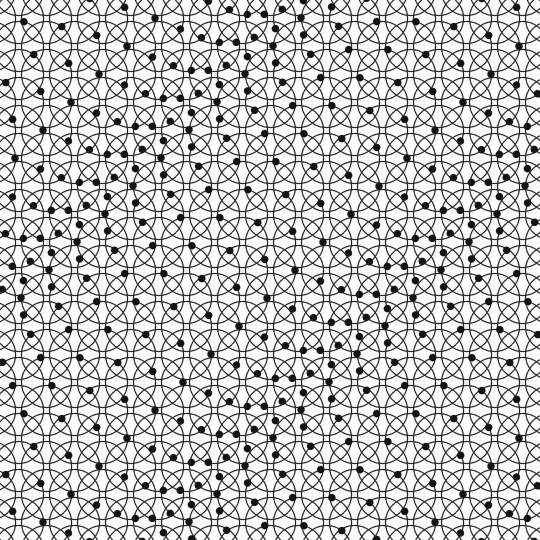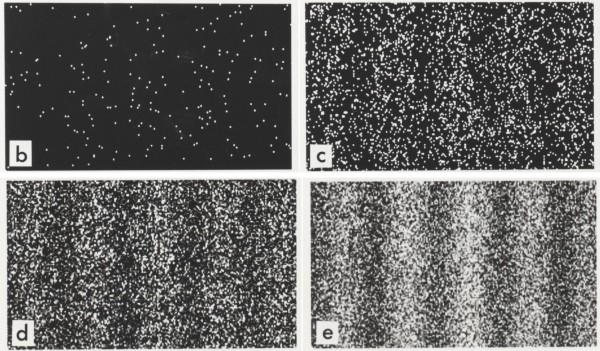“You asked me how to get out of the finite dimensions when I feel like it. I certainly don't use logic when I do it. Logic's the first thing you have to get rid of.” -J.D. Salinger
Now that gravitational waves have been verified to exist, and the first black hole-black hole merger has been definitively detected by LIGO, it's time to start thinking of the next steps in gravitational wave astronomy. The biggest one we can dream of, perhaps the holy grail of this field of study, is to go beyond General Relativity itself, and to find evidence that gravitation is a truly quantum theory at its core.
 Image credit: Dave Whyte of Bees & Bombs, via http://beesandbombs.tumblr.com/post/134366721074/ok-couldnt-resist-rema….
Image credit: Dave Whyte of Bees & Bombs, via http://beesandbombs.tumblr.com/post/134366721074/ok-couldnt-resist-rema….
If that's true, then these gravitational waves should exhibit wave-particle duality, just like all the other quantum entities we know of. In this case, detecting the wave-like phenomenon, which took a century to do, was the easy part; detecting the particle nature of gravitons will be the hard part. Nevertheless, even though this is likely beyond the reach of LIGO, future missions will have a chance to see these quantum effects down the road.
 Image credit: Wikimedia Commons users Dr. Tonomura and Belsazar. Note how the interference pattern becomes discernible with enough particles, even though they’ve been passed through the double slit one-at-a-time.
Image credit: Wikimedia Commons users Dr. Tonomura and Belsazar. Note how the interference pattern becomes discernible with enough particles, even though they’ve been passed through the double slit one-at-a-time.
Go get the whole quantum gravitational story on this week's Ask Ethan!

If I am understanding correctly, there is a gravitational pull between any two massive bodies and that gravitational pull is facilitated through VIRTUAL gravitons. The radiation of VIRTUAL gravitons does not consume any energy or mass from either of the massive bodies and so the gravitational field could theoretically persist until the end of time. The mechanism isn't entirely unsimilar to how virtual photons facilitate magnetic attraction. However in the merger of black holes some energy is turned into REAL graviton particles and those should exhibit the particle-wave duality just as REAL photons do. A gravitational wave is to a gravitational field what a burst of light is to a magnetic field. Am I understanding this correctly?
@Denier #1: You have it exactly right. My only (very small) nit-pick is that your phrase "radiation of virtual gravitons" is extremely inaccurate.
If you want to analyze the situation perturbatively, using Feynman diagrams, you can sort of describe the first couple of those diagrams as one body "radiating a graviton" which is captured by the other. But that is only one particular mathematical tool available, and doesn't accurately describe nature.
A slightly better description is that the continuous, ongoing exchanges of gravitons (or virtual photons, or whatever is involved in the force of interest) ends up producing a static, classical-looking, interaction. You can't (in real life) pick out just one "virtual particle" from that continuous sea of exchange, and identify "it" as radiating from one body to another.
The rest of your statement, from "The mechanism..." all the way through, is exactly correct.
@Michael Kelsey #2
The part that throws me is where the gravitational wave is described as a tensor wave. I had thought tensors were wrapped up in force carrying virtual particles. Virtual particles can't exhibit particle-wave duality because they can't exist long enough to be a particle. I am having trouble reconciling the idea of what I thought a gravitational wave was with the descriptor of 'tensor wave'.
@Denier #3: The force-carrying particles we have observed (photons, W+- and Z0, and gluons) are _vector_ particles. That means they have spin-1 and are symmetric under parity.
The graviton is a _tensor_ particle. That means it has spin-2. One of the side-effects of being a tensor particle is that it operates in _both_ transverse directions to propagation, not just one. That's why you see cartoons of the effect of gravitational waves compressing in one direction, and stretching in the other.
If you can't get into the math, you're just not going to understand this. Good luck!
Not a scientist and not doubting the LIGO result but how can you be sure that the result i correct unlike the infamous BICEP for example ? I mean no other experiment exists and their result hasnt been verified by someone else ?
Kind regards
Johan
@Michael Kelsey #4
I am admittedly fuzzy on the idea of spin, but I had thought a vector was a rank 1 tensor (and a scalar was a rank 0 tensor). Am I mistaken or does Physics use the terms of 'vector' and 'tensor' differently?
@Denier #5: Fine, be pedantic :-) In physics, the bosons are all "tensor" particles, where the tensor rank corresponds directly to their spin. The spin-2 graviton follows the symmetries of a rank-2 tensor.
In particle physics, we have words which are synonyms: a rank-0 "tensor" is a scalar (spin 0) particle (or pseudoscalar if it has negative parity); a rank-1 "tensor" is a vector particle (with generically three states, spin z=+1, 0, and -1); and a rank-2 "tensor" is a tensor (spin 2) particle.
Then there are the half-integer spinors (fermions) of which the elementary particles only have spin 1/2 (in units of h-bar). These are not properly tensor-like particles at all, as their spin components transform more complexly, via Fermi-Dirac statistics.
@Michael Kelsey #6
Thanks. Getting the vocabulary down helps although I'd love to see Ethan do an article on spin. Before this thread all I knew was that it was a quantum mechanical term that didn't describe something spinning, and if you spin an electron 360 degrees it doesn't return to its starting point but changes it from an up to a down. To spin an electron all the way around so that it looks like it did when you started spinning you have to turn it 720 degrees, except that you're not really spinning it because it is actually a zero volume point with no sides to rotate.
Now I know the spin number corresponds to tensor rank even though I haven't the slightest clue as to why that is. A few more threads like this one and I'll be dangerous.
@ Denier
"If I am understanding correctly, there is a gravitational pull between any two massive bodies and that gravitational pull is facilitated through VIRTUAL gravitons."
I think this mental picture can only lead to problems down the road, because it treats gravity as a classical force, which einstein proved it isn't. at least not the force between two bodies. instead it might be some force acting somehow on spacetime.. or making spacetime.. don't know how to express it. But it can't be really viewed as pull between bodies. It might be viewable as a pull between a body and it's surrounding spacetime.
p.s. just as an example.. it's not the earth mass that is pulling you... instead you are in free fall in spacetime, with earth curving it slightly.. and sun curving it even more.. basically both earth and you are in free-fall around the sun and it's the atomic forces keeping you on top of earth.
and we calculate the metric (how the energy density of that piece of spacetime affects the metric..or the trajectory...for every time step. not a force between to bodies.. but a "state of affairs" in every single patch of space it travels through.
@Denier:
This progression can naively be conceptualized as scalar → vector → matrix. To get all the way, you're going to have to take in the notion of a vector space and how choosing a basis for it fixes the coordinates (which is needed for introductory QM in any event).
After that, this Stack Exchange item isn't bad if you ignore the comments. The related link way at the bottom might be more on-point.
And by beeing sure I mean in the context that someone on this site often writes "Extrordinary claims require extrordinary evidence" if I remember correctly.
Best regards
Johan
"@Denier #1: You have it exactly right. My only (very small) nit-pick is that your phrase “radiation of virtual gravitons” is extremely inaccurate. "
The phrasing is understandable, though. Its major flaw is that it leads itself to incorrect analogising.
"Exchange of virtual gravitons" would be as concordant and less prone to abuse (if still quite unusful compared to the field equations method).
If it's not about AGW or a few other pet peeves, Denier is quite rational. It was not likely that this was a case of wanting to lead to a ridiculous conclusion by "plausible" agreements.
SL@9, Edward Current has a quite old now vid on his Youtube channel showing how bending spacetime leads to an appearance of force when you try to map curved space onto euclidian geometry.
It was IMO an excellent depiction.
@Sinisa Lazarek #9
I totally get what you are saying about curved space, but I need vocabulary help with this little bit. Is 'classical' by chance a physics synonym for vector (rank-1 tensor) facilitated? Or what exactly did Einstein prove?
No, it means, in this context, the Maxwell era of science, pre-Einstein and Shroedinger.
There are other contexts, where it means "in the realm of the relatively slow and midsized", such as human scale observation. This isn't that context.
And Einstein proved that there was no need for a force for gravity to *appear* to be a force (much like the nonexistent centrifugal force is the result of trying to draw inferences of euclidian inertial frames of reference in a rotating system: there IS no centrifugal force, it just looks like there is one).
Whether you count that as proving anything is up to individual interpretation of the boundaries of the meaning of the word.
@ Denier
what I mean by not a classical force.. I mean that it's not a force (it's not any action/exachange) etc.. between TWO or more bodies. Let me try a different mental image.. in ABSENCE of any force... object will either stand still or move in a straight line... that those things are same is the equivalance principle. And that's what GR is based on. All objects travel in a straight line from their reference point. No force is acting on them. Energy/mass distorts spacetime .. causing the trajectories to curve.. while still looking straight from local reference points. Or take two solar mass trucks on a solar highway. There is no force between two trucks... instead both trucks "exert" a force on the highway itself, causing the highway to bend. That's what energy stress tensor does.. it "works" on the geometry of the coordinate system. It doesn't work on a second truck.. doesn't care about it :) just cares about energy density in it's surrounding.
If you take the path of force exchange between two bodies.. you just end up back at newtons equation.. or maxwell's. and you're stuck. spacetime... in a matter of speaking is a real thing... throw it away and start thinking that's it's an interaction of two objects, and you are in trouble.